Meal 59: Ethiopia
 What makes Ethiopian food so delicious and rich? For sure, the classic berbere mix, that blend of chilies and roughly half your spice cabinet, lends a complexity of flavor uncommon in most cuisines. And there's something to be said for eating with your hands, grabbing bite-sized morsels with strands of the tangy injera flatbread. But what I learned from this meal is that it's an ingredient common to virtually every cuisine, cooked in a simple but rare way, that provides the solid concrete foundation for this ancient and excellent cuisine.
What makes Ethiopian food so delicious and rich? For sure, the classic berbere mix, that blend of chilies and roughly half your spice cabinet, lends a complexity of flavor uncommon in most cuisines. And there's something to be said for eating with your hands, grabbing bite-sized morsels with strands of the tangy injera flatbread. But what I learned from this meal is that it's an ingredient common to virtually every cuisine, cooked in a simple but rare way, that provides the solid concrete foundation for this ancient and excellent cuisine.
The secret, my friends, is onions, the red kind, cooked without any oil or fat, low and slow. Sometimes with a splash of water, but equally often just bare on the pan. I thought I was making it all rich and indulgent by cooking them for an hour or so, but apparently that wasn't enough. Mikael, whose family comes from Ethiopia, said that often the onions are cooked for hours on end until they get impossibly soft and flavorful. It's so important that often, the cook of the house will buy these onions pre-cooked, so they don't have to spend all the time but still get the flavor.
We had a full house for this one, pulling out our new folding table. We welcomed Alex, Ruben, Joanna, Paul, Brian, Sarah, Mikael, Hanna, and Martyna.
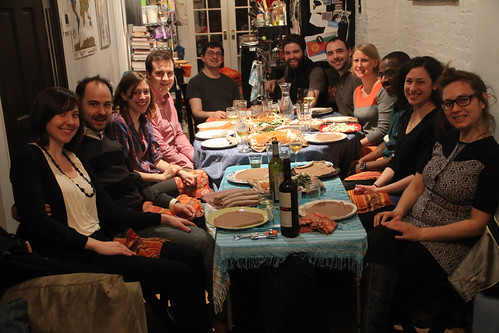
Tej | Honey wine

This famous Ethiopian honey wine — or, more appropriately, mead — is fermented with gesho, a hops-like bittering agent. The drink is surprisingly smooth, and although sweet, not at all cloying. Fortunately we only had two bottles, otherwise we might have discovered first-hand the apparently wicked hangover it can give!
Injera | Spongy sourdough crêpes | Recipe on Djibouti page
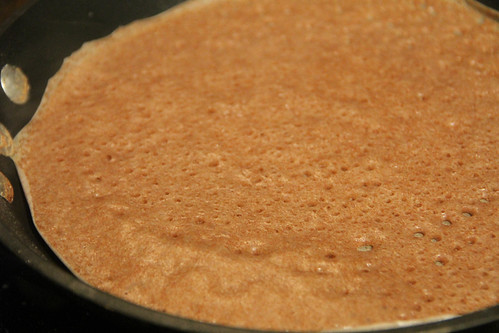
Of the past ten meals, three have featured this tangy, spongy crêpe-like staple bread (the others were neighboring Djibouti and Eritrea). I've gotten pretty good at the process by now, from the fermenting to the blending to the cooking. This time I had to combine two different teff flours, and I don't think the result was quite as good — honestly I think the best was for Djibouti when I made it purely with the Bob's Red Mill flour. Although, come to think of it, maybe the difference was that I didn't have quite enough baking powder for the recipe, though there did seem to be enough holes. Hm. Oh well, won't be making it again until Somalia, and it seems that they use a different recipe anyway. So long, and thanks for all the bubbles!
Kitfo | Raw minced beef in warmed spiced butter | Recipe
Ayib | Fresh cheese | Recipe
Mitmita | Spice blend | Recipe
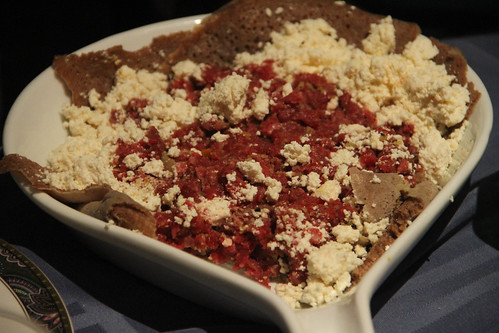
The Ethiopian food we know in the US is generally from the Amhara and Tigray people, but there are many other cultures within the country. None has had such a large impact on the national cuisine relative to its size as the Gurage. They make up no more than 3% of the over 80 million Ethiopians, but their food is popular and sought far and wide. Mikael likens it to the influence of soul food in the US. As far as what the Gurage have to offer, raw beef is the most notable. They have it in chunks or even slices off the leg, but kifto, the finely minced version, is what they're best known for.
It's really pretty simple to make, but as with many raw dishes, it's important to have high-quality ingredients and prepare them carefully. Contrary to what you might expect, you shouldn't get a tender cut of beef; a filet mignon or tenderloin would just be too mushy and not flavorful enough. Instead, the sort of cut that's tougher and would normally take a long time to cook, such as top round, is best. (And, incidentally, cheaper.) Nowadays most people use a meat grinder or even a food processor to chop the meat fine, but I chose the traditional (and very laborious) method of chop, chop, chopping with a big knife.
The rest is quick and straightforward: melt niter kibbeh, the spiced clarified butter, over low heat in a pan. As soon as it's melted, remove the pan from the heat, add the beef and a bit of the mitmita spice (which is essentially chilies, cloves, and a musty sort of cardamom), mix very quickly to prevent the meat from heating up too much but letting it get warm from the butter, and serve immediately. If you're not fond of the texture or slight health risk of raw meat, you can cook it a little longer until it looks like Hamburger Helper; it'll still taste good and be culturally appropriate. I made both, putting them on top of some injera, and sprinkled with some fresh homemade cheese, which was shockingly easy to make, but didn't have as much flavor as I'd hoped.
Doro wat | Chicken stew | Recipe
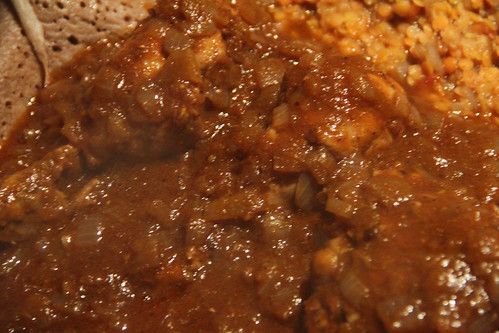
What this dish lacks in looks it more than makes up for in flavor. Those aforementioned onions then cook even longer with spices and that spiced butter, and then with poached chicken, getting the flavors to meld all over the place. I enjoyed this one a lot more than the equivalent Eritrean one, but that might be more that it's a better and longer-cooking recipe written by a restaurant owner, rather than an ethnographer like the other one.
If you're craving this Ethiopian classic, go boldly forth with this recipe! My one tweak is to not dump in all the water at once toward the end, it got too thin and I had to boil it down. Rather, add bits at a time so you can keep it simmering while getting the thickness right. (Also, it might be heresy but we skipped the hard boiled eggs and didn't miss them.)
Misir wat | Lentil stew | Recipe
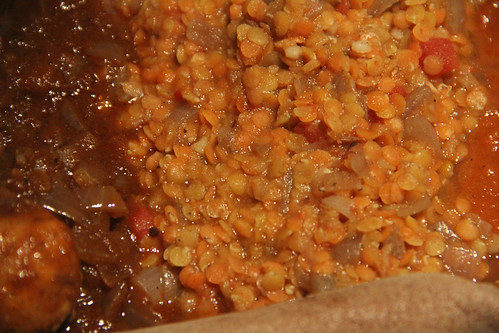
In many cultures, lentils are a good-luck charm for wealth because they look like coins. But fortunately, this dish is extremely inexpensive to cook, and really tasty at that. Plus, it's vegan! The technique of this dish is interesting, in that instead of boiling the lentils in a lot of water like I've normally done, you instead simmer it in just enough to get them plump and soft, and don't drain anything.
Shiro wat | Spiced bean-flour porridge | Recipe
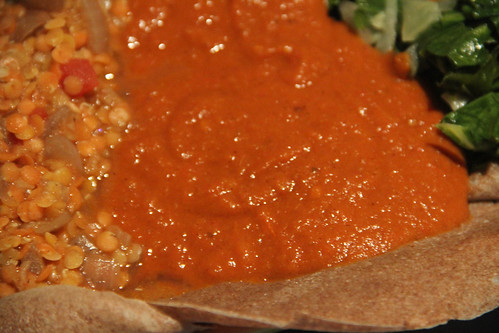
The Ethiopian Christian Orthodox calendar has many "fast" days, where no animal products may be consumed. Accordingly, this otherwise meat-loving culture has developed a vegetarian cuisine that gives India a run for its money in terms of taste, variety, and nutrition. A great example is this dish, where a base of bean flours is built up into a rich paste with tomatoes, spices, and oils. It's tasty, filling, and packs plenty of protein. It's also supposed to be inexpensive, although the only shiro flour I could find was at Kalustyans, $5 for a packet that turned out to be less than a cup of powder, but amazingly that's all that's needed for a large amount of this dish.
Gomen | Collard greens | Recipe
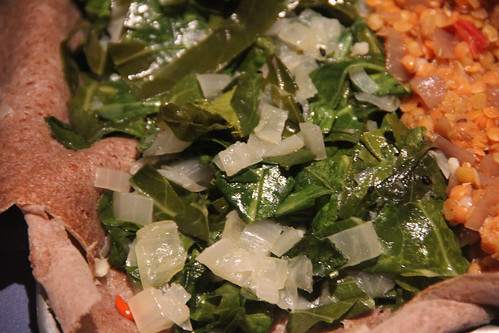
Many people only know collards as a long-stewed green made tasty and salty with ham. This is a pretty different approach. Indeed, these tough greens need to cook for a while, there's no way around that, but in true Ethiopian style, it's spices rather than salt that lend the flavor. I would seriously consider making this tasty dish as a side for all sorts of things far beyond Ethiopian; it might go great with roast chicken.
And that's a wrap! Or whatever you call it when you grab food with injera. Anyway, we've been on the road for a bit, but when we're back, we'll be throwing together a French feast that we're already researching. Can't wait to share it!